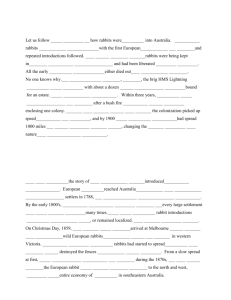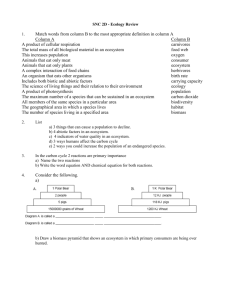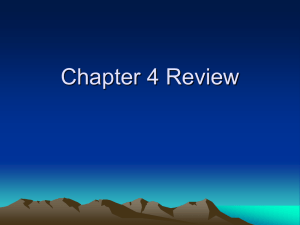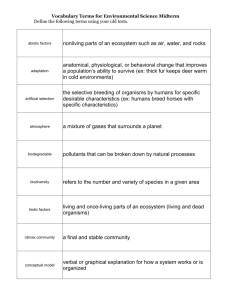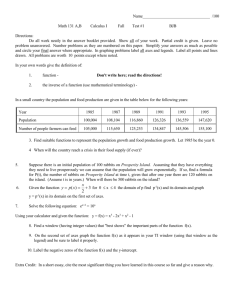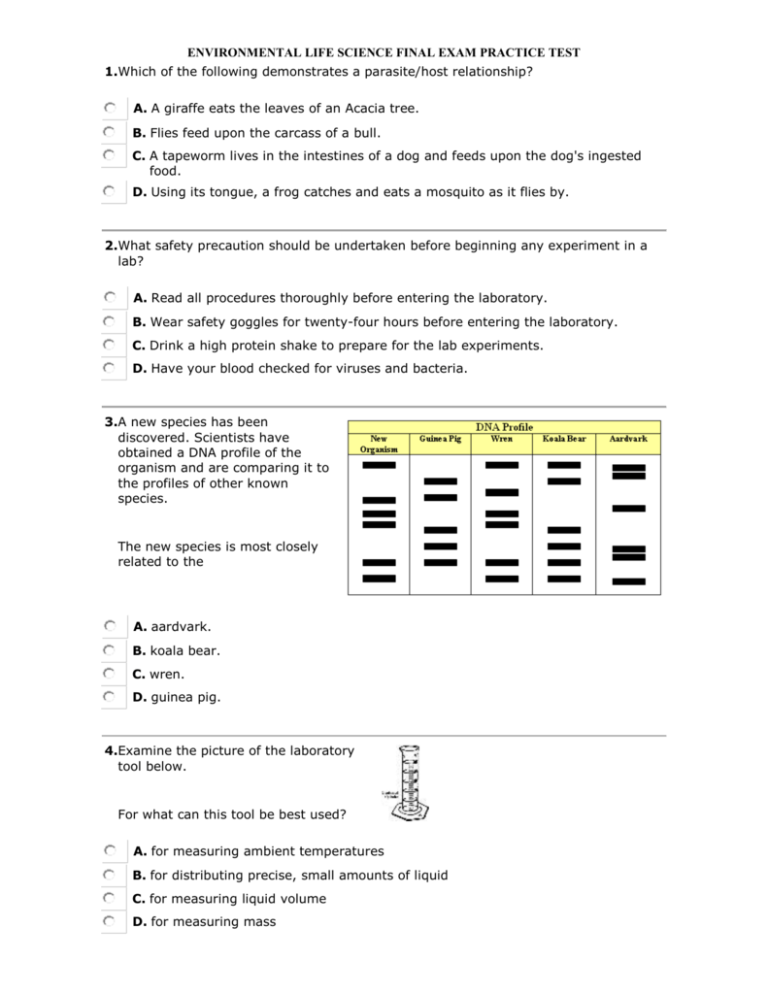
ENVIRONMENTAL LIFE SCIENCE FINAL EXAM PRACTICE TEST
1.Which of the following demonstrates a parasite/host relationship?
A. A giraffe eats the leaves of an Acacia tree.
B. Flies feed upon the carcass of a bull.
C. A tapeworm lives in the intestines of a dog and feeds upon the dog's ingested
food.
D. Using its tongue, a frog catches and eats a mosquito as it flies by.
2.What safety precaution should be undertaken before beginning any experiment in a
lab?
A. Read all procedures thoroughly before entering the laboratory.
B. Wear safety goggles for twenty-four hours before entering the laboratory.
C. Drink a high protein shake to prepare for the lab experiments.
D. Have your blood checked for viruses and bacteria.
3.A new species has been
discovered. Scientists have
obtained a DNA profile of the
organism and are comparing it to
the profiles of other known
species.
The new species is most closely
related to the
A. aardvark.
B. koala bear.
C. wren.
D. guinea pig.
4.Examine the picture of the laboratory
tool below.
For what can this tool be best used?
A. for measuring ambient temperatures
B. for distributing precise, small amounts of liquid
C. for measuring liquid volume
D. for measuring mass
5.A science class is studying solubility, so they perform a lab to answer the question,
"How does temperature affect the solubility of sugar in water?" The results of their
experiment appear below.
Amount of Sugar Dissolved at Different Temperatures
Temperature (°C)
Grams of sugar that dissolvedin 100 g water
0
180
20
205
40
240
60
280
80
360
100
490
Which of the following conclusions best answers the experimental question?
A. The solubility of sugar in water increases with an increase in temperature.
B. The solubility of sugar in water is 490 g sugar/100 g water at 100°C.
C. Sugar is composed of carbon, hydrogen, and oxygen atoms covalently bonded
together.
D. All of these statements are valid answers to the experimental question.
6.Decomposers are a necessary part of a healthy ecosystem because they
A. keep populations of herbivores from exceeding the ecosystem's carrying
capacity.
B. are a major food source for herbivores, carnivores, and scavengers.
C. capture energy from the Sun and convert it to chemical potential energy.
D. return nutrients to the environment so matter and energy can begin another
cycle.
7.Select a testable research question.
A. If students listen to music while studying, will their grades improve?
B. Studying with music changes students' grades.
C. Should music be permitted in libraries?
D. Does listening to music help students?
8.A large tract of land is purchased by a commercial agricultural company. The land is
cleared of its native flora, and a single crop is planted instead. What is the effect of
this action?
A. The cost of the planted crop increases.
B. The biodiversity of the area is reduced.
C. There is an increase in the variety of foods.
D. There is a reduction in the size of the land.
9.When a(n) __________ organism enters an established ecosystem, it competes with
some of the native organisms for food. As a result, the entire ecosystem can be
thrown out of balance.
A. pioneer
B. symbiotic
C. invading
D. large
10.Jerome is performing an experiment for the science fair.
He wants to know how long it takes for water to evaporate at varying temperatures.
So, he pours exactly 1 mL of water into each of five identically-sized test tubes.
Then, he places the test tubes in five different incubators which are set at 20°C,
30°C, 40°C, 50°C, and 60°C. Finally, he measures the amount of time it takes for
the water to completely evaporate at each temperature.
What is the independent variable in Jerome's experiment?
A. the quantity of water in each test tube
B. the amount of time it takes for the water to evaporate
C. the size of the test tubes
D. the temperature of the incubator
11.Which of the following populations is likely to have the most genetic variation
among its members?
A. a large population that has existed for a short period of time
B. a large population that has existed for a long period of time
C. a small population that has existed for a long period of time
D. a small population that has existed for a short period of time
12.Which of the examples below describes a mutualistic relationship between
organisms?
A. bacterial flora in the intestines of a cow
B. insects pollinating roses
C. all of these
D. ants living on a shrub and protecting it
13.The American bullfrog is native to much of the eastern United States. This species
has successfully begun to spread west as an invasive species. It is thriving in the
western United States because of its large size, high mobility, and tremendous
reproductive capabilities.
American bullfrogs have very generalized eating habits and often eat the same food
sources as the native frog species in the western United States, causing a reduction
in the overall food supply.
The relationship between the American bullfrog and native frog species in the
western United States can best be characterized as ______.
A. parasitism
B. competition
C. predation
D. mutualism
14.Jenny was worried about how some pollutants in a lake near her home were
affecting the levels of dissolved oxygen in the water, so she designed the following
experiment.
First, she collected five 10-gallon aquariums and filled each with water from her tap.
Then, she tested the initial oxygen level of the tap water.
Next, she put a tablespoon of different pollutants, including gasoline, cooking oil,
paint, and lawn fertilizer, in each of four of the tanks. She stirred those four tanks
for 1 minute each to help the pollutant dissolve or spread out in the tank.
Finally, she tested the oxygen level in each tank once every hour and recorded her
results in the table below.
Tank
Pollutant
in water
1
none
2
gasoline
3
cooking oil
4
paint
5
lawn fertilizer
Initial
O2 level
(without pollutants)
O2 level
after 1 hour
What is the dependent variable in Jenny's experiment?
A. amount of pollutant put in each tank
B. initial oxygen level in tank without pollutant
C. pollutant in each tank
O2 level
after 2 hours
...
D. levels of O2 in each tank
15.Which of the following is an example of natural selection?
A. A farmer breeds a certain cow that produces more milk than his other cows to
produce more cows that produce a lot of milk.
B. Owls sleep during the day, and doves sleep during the night.
C. A species of corn is genetically modified to produce a natural insecticide,
resulting in an increase in crop growth and a decrease in insect population.
D. An aloe vera plant species possessing a trait for extra thick leaves survives a
long drought in a desert, and an aloe vera species that has thinner leaves does
not.
16.An animal that lives in a desert biome will most likely have adaptations that help the
animal to
A. store body fat.
B. swim efficiently.
C. conserve water.
D. insulate its body.
17.In the following food web, what organism(s) are primary consumers?
A. algae and oak trees
B. caterpillars, minnows, sparrows, and trout
C. bears and mountain lions
D. aphids, caterpillars, minnows
18.The diagram below shows a food chain.
Grass
Rabbit
Weasel
Fox
Fungi
Which population would most likely increase if the weasel was removed from the
food chain?
A. fungi
B. grass
C. rabbit
D. fox
19.Establishment of communities in newly formed environments, such as volcanic lava
flows or sand bars, is called __________.
Development of new communities in disturbed environments, such as a burned or
clear cut forest, is called __________.
A. secondary succession, tertiary succession
B. primary succession, secondary succession
C. secondary succession, primary succession
D. tertiary succession, primary succession
20.Linda wants to measure out 178.2 mL of a zinc chloride solution. Which of the
following graduated cylinders would be the best choice for Linda to use?
A. 175 mL cylinder graduated in 0.5 mL increments
B. 250 mL cylinder graduated in 1 mL increments
C. 200 mL cylinder graduated in 0.5 mL increments
D. 500 mL cylinder graduated in 10 mL increments
21.In the carbon cycle, carbon is taken in by plants
A. as ammonia in the process of assimilation.
B. as carbon dioxide in the process of photosynthesis.
C. as water vapor in the process of photosynthesis.
D. as carbon dioxide in the process of decomposition.
22.An organism that is able to move and not produce its own food could be classified
into which of the following kingdoms, shown in the table below?
Kingdom
A. Protista
B. Animalia
C. Plantae
Able to move Produce own food
Protista
some
yes
Fungi
no
no
Plantae
no
yes
Animalia
yes
no
D. Fungi
23.Which level in a food web contains the highest amount of total available energy?
A. secondary consumer
B. producer
C. primary consumer
D. decomposer
24.
Classification of Photosynthetic Organisms
Trait
Green Algae
Angiosperm
Gymnosperm
Fern
Has true roots,
stems, and leaves
No
Yes
Yes
Yes
Produces seeds in cones
No
No
Yes
No
Produces seeds in fruit
No
Yes
No
No
Produces spores
No
No
No
Yes
Dr. Musgrove finds a new species of plant. The plant has true roots, stems, and
leaves and reproduces by producing seeds inside cones.
Based on the table above, the new plant species most likely belongs to which of the
following classification groups?
A. angiosperm
B. gymnosperm
C. fern
D. green algae
25.The diagram below depicts the water cycle.
Which of the following is represented by the number 2?
A. surface runoff
B. evaporation
C. condensation
D. precipitation
26.
Which of the following is represented by the number 4?
A. condensation
B. precipitation
C. surface runoff
D. evaporation
27.Which human activity has had the greatest impact on climate change?
A. production of nuclear waste
B. burning fossil fuels
C. building skyscrapers
D. deforestation
28.Silkworms are grown commercially for the silk that they spin when they make their
cocoons. The silkworm eats White Mulberry leaves. Can the relationship between
the silkworm and the Mulberry plant be considered commensalism?
A. Yes; both organisms benefit from this relationship.
B. No; no one benefits from this relationship.
C. No; the plant is harmed by the silkworm.
D. Yes; the silkworm benefits and the plant is not affected.
29.Dr. Grey discovers a new drug that she hypothesizes will increase fat storage in
rabbits. She designs an experiment to test her hypothesis.
Dr. Grey separates twelve rabbits into two equal groups and measures their body
fat individually. She gives one group of rabbits the drug but does not give the drug
to the other group. She keeps everything else about the rabbits' living environment
the same, including the amount of water and food provided. After a month, she
measures the body fat of the rabbits in both groups.
What is the control in Dr. Grey's experiment?
A. the quantity of experimental drug used
B. the group of rabbits that are not given the drug
C. the group of rabbits that are given the drug
D. the body fat of the rabbits
30.Wolves and foxes both hunt snowshoe rabbits. If there was an increase in the
number of wolves, which of these is the most likely result?
A. The number of snowshoe rabbits would increase, and the number of foxes would
increase.
B. The number of snowshoe rabbits would decrease, and the number of foxes
would decrease.
C. The number of snowshoe rabbits would increase, and the number of foxes would
decrease.
D. The number of snowshoe rabbits would decrease, and the number of foxes
would increase.
31.The diagram below shows a variety of
animals at different stages of
development.
Which of the following statements is
supported by this diagram?
A. The developmental stages of animals are radically different; they do not possess
any similarities at all.
B. There are similarities in the developmental stages of different organisms in the
animal kingdom.
C. Diverse organisms in the animal kingdom possess more similarities during the
fetal stages of development than during their embryonic stages.
D. Humans undergo more stages of development than other animals, such as
salamanders, tortoises, chickens, and pigs.
32.Which of the following is a biotic factor that limits the number of deer in an
ecosystem?
A. a predator
B. drought
C. temperature
D. flooding
33.A mushroom grows on a rotting log. As a result, water and nutrients from the log
are released into the soil. What type of organism is the mushroom?
A. decomposer
B. producer
C. predator
D. prey
34.The diagram below shows several fossilized remains that were discovered at an
archaelogical dig site.
The molecular and structural similarities observed among these organisms is best
explained by which of the following?
A. genetic mutations
B. human impact
C. binary fission
D. natural selection
The carbon-oxygen cycle is shown below.
35.Carbon dioxide is released into the air or water during which of the following?
I. photosynthesis
II. decomposition of plants and animals
III. erosion of limestone rock
IV. burning of coal by power plants
A. I and III only
B. II, III, and IV only
C. I and IV only
D. I, II, III, and IV
36.Which of the following describes the fundamental difference between prokaryotic
and eukaryotic cells?
A. Eukaryotic cells are only found in protists, bacteria, and viruses.
B. Prokaryotic cells are all viruses and rely on the infection of a host cell to
replicate.
C. Eukaryotic cells are the only type of cells that can possess a cell wall.
D. Prokaryotic cells do not have a true nucleus or membrane-bound organelles.
37.Jakira's teacher gives her a classification chart to use while observing animals in the
wild.
Classification Chart
Jakira observes an animal in the forest near her house that lives on land and has
scales. Which group does this organism most likely belong to?
A. amphibian
B. bird
C. reptile
D. fish
38.Loss of biodiversity ___________.
A. causes no change in an ecosystem
B. increases the variety of species in an ecosystem
C. strengthens an ecosystem
D. weakens an ecosystem
39.Jake is performing an experiment to test the effectiveness of a specific brand of
fertilizer.
Jake plants 25 rosebushes into five equal groups and gives each group a different
amount of the fertilizer every week. He measures the initial height of the
rosebushes and then measures their growth after two months. He averages the
growth of each group and records this data in the table below.
Fertilizer and Average Rose Growth
Amount of Fertilizer Average Growth
Given Weekly
of Rosebushes
0 grams
3.5 inches
25 grams
3.7 inches
50 grams
4.2 inches
75 grams
4.5 inches
100 grams
2.7 inches
Jake then makes a graph of his results.
Jake incorrectly constructs his graph. Which of following is wrong with Jake's graph?
A. The graph's axes are not separated into appropriate intervals.
B. The independent and dependent variables are on the wrong axes.
C. The graph's axes are not labeled.
D. The graph does not have a title.
40.How might an environment be affected if humans introduce a new type of plant to
the environment?
A. The plant may compete with other plants for light.
B. The plant may become another food source for animals.
C. all of these
D. The plant may be poisonous and harmful to animals.
Copyright © 2012 Study Island - All rights reserved.
{ts '2012-05-29 1
1
16 31
2
17 32
3
18 33
4
19 34
5
20 35
6
21 36
7
22 37
8
23 38
9
24 39
10 25 40
11 26
12 27
13 28
14 29
15 30
8581813
7667
36493340
0
0
58111|153648|24

